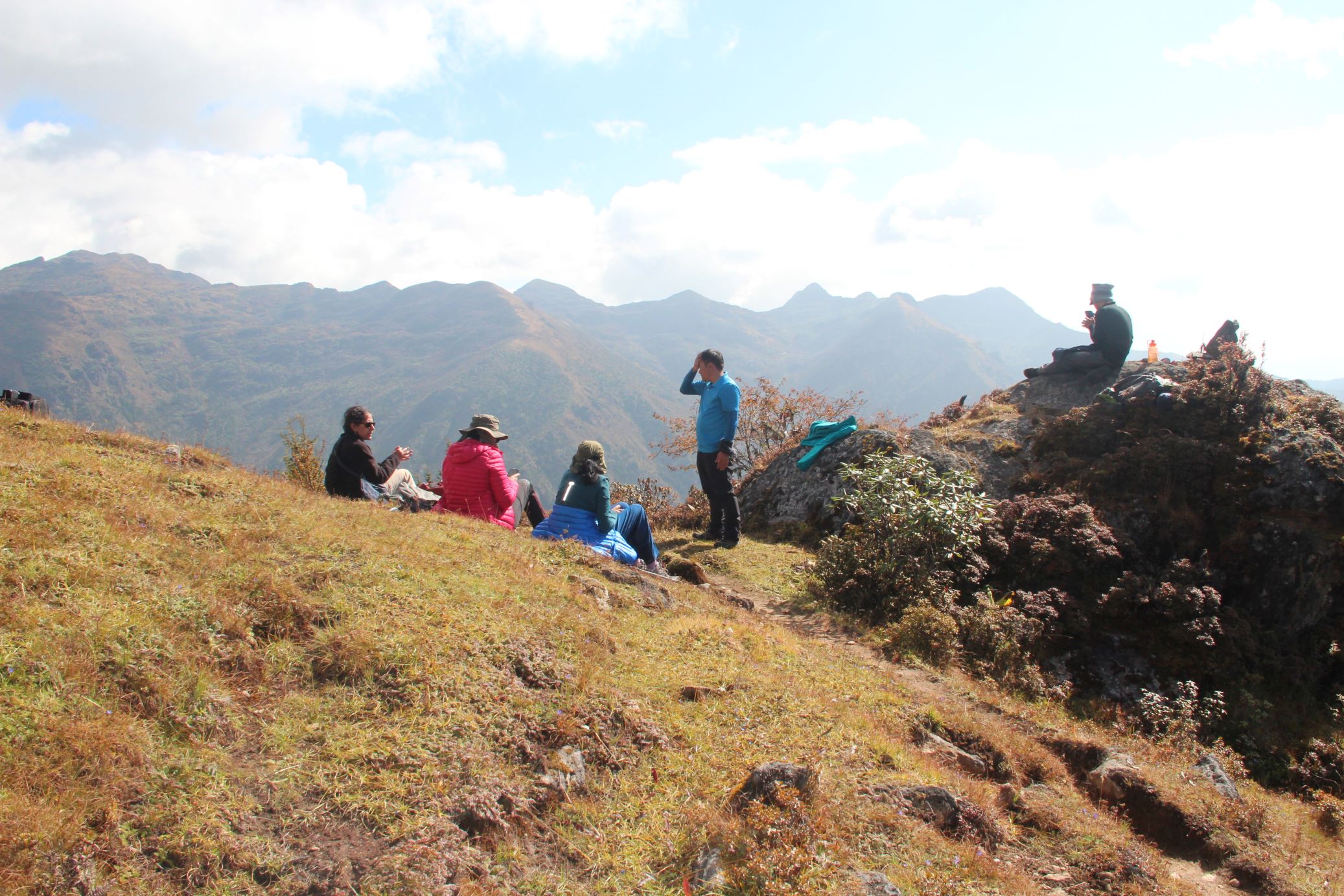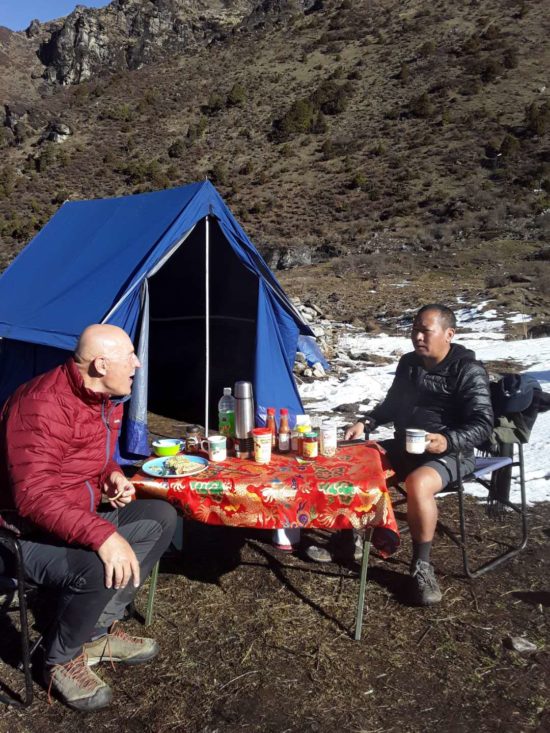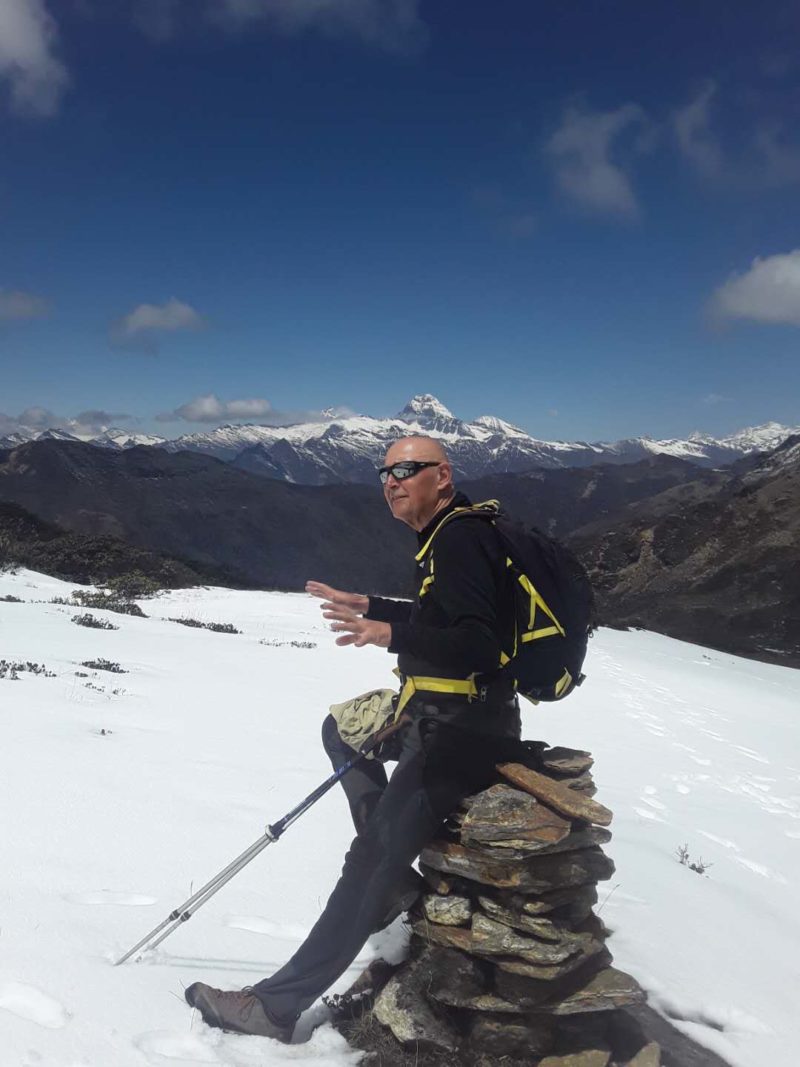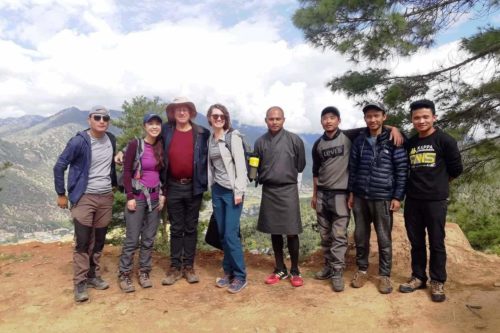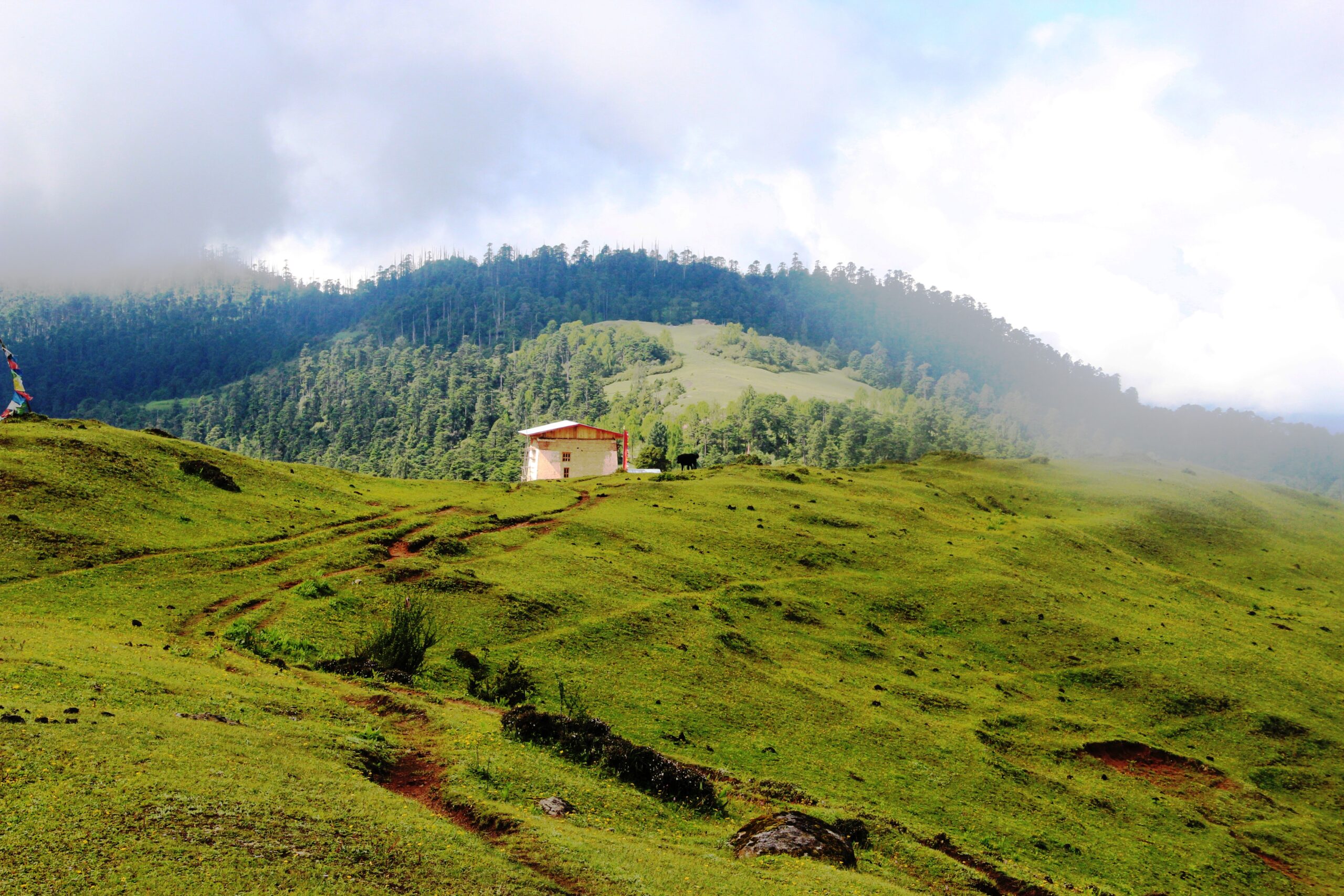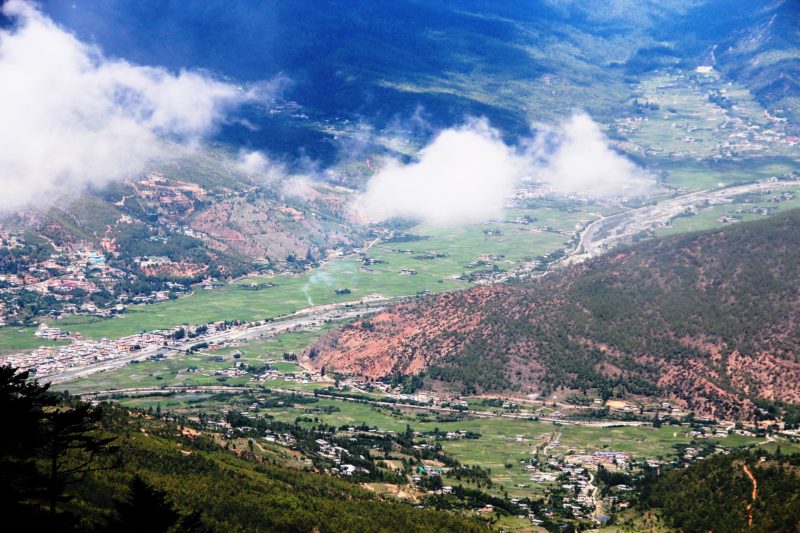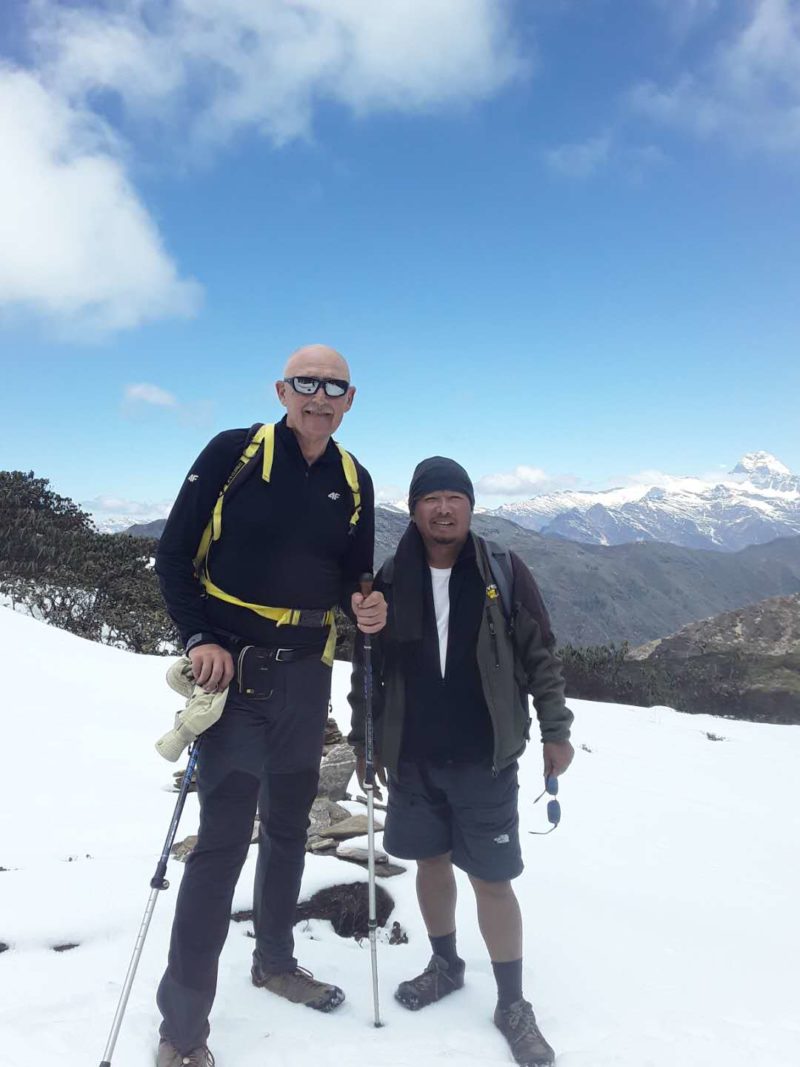The Druk Path Trek in Bhutan is an excellent choice for those with a tight schedule. A short 5-day trek crossing the chain of mountains that separates two districts, Paro & Thimphu, or vice versa. This is a classic walk along high, windy ridges, past ruined forts that long ago guarded against Tibetan invasion. The route is sparsely inhabited with wonderful lakes teeming with fish and the area is famous for its spectacular rhododendrons forest which bloom in spring.
The view of the Himalayas can be seen during late autumn, spring, and winter. After the initial climb, the route is not too hard and, if needed, there is access down to a road from several spots. Part of the route follows the original mule track that linked Bhutan to the Indian border.
Trip Map
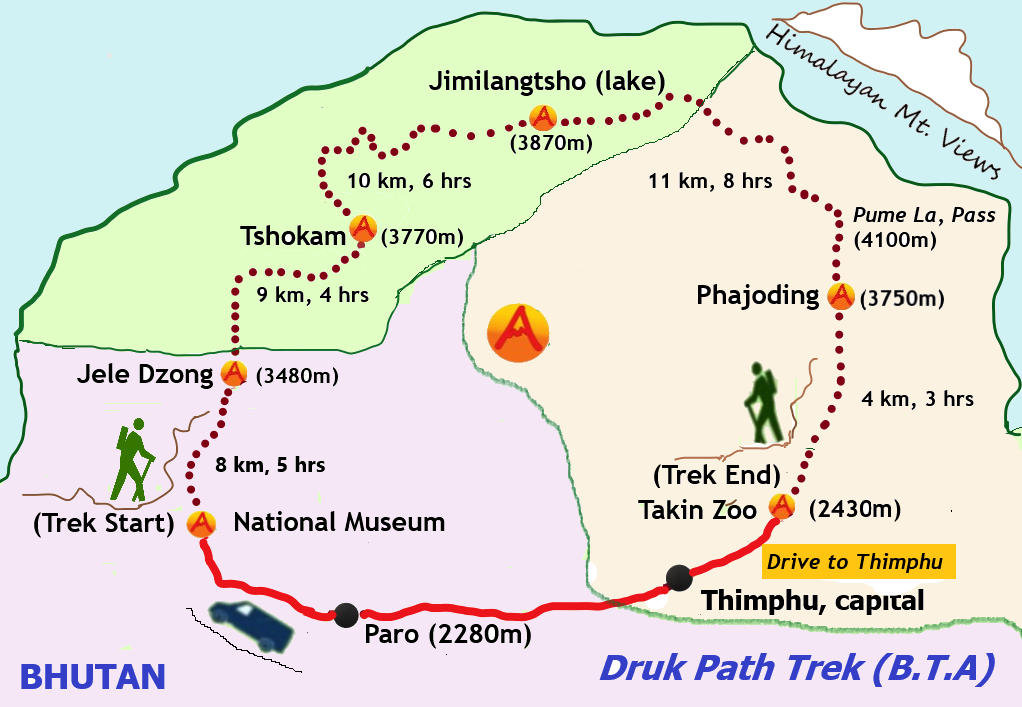
Depart Bangkok international airport by our Drukair (Royal Bhutan Airline). On arrival at Paro international airport, you will be received by our representative and escorted to the hotel. After an early lunch, you’ll visit the national museum (Ta-dzong). Once it was the watch tower of Paro Valley from 1616 A.D to 1907 and it was converted into the National Museum in 1968. The museum stands on a promontory overlooking the Paro Valley. Also, visit the Paro dzong which is the seat of the district administration as well as the home for the monastic school. The central tower (Utse) of the dzong, with its superb woodwork, is one of the most beautiful in the country. The dzong was built in 1645 A.D. After the dzong, if you want walk downhill for 10 minutes crossing a traditional wooden bridge. Overnight halt stays at the hotel in Paro.
Day 02: Excursion to Tiger’s Nest
Right after the breakfast drive towards the road point to Taktshang. Taktshang Monastery, the most famous of Bhutan’s monasteries is perched on the side of a cliff 900m above the Paro valley floor. Taktshang means “Tiger’s Nest,” so named because Guru Rimpoche reportedly flew to the site of the monastery on the back of a flying tiger in the late centuries of the first millennium. The monastery is perched on a cliff nearly 3,000 ft above the Paro Valley floor. This day hike is not only historically and culturally interesting, but also incredibly scenic! It takes about two hours to reach the cafeteria, which gives a breathtaking view of the Tiger’s Nest. If you still feel like hiking then you can take another hour to reach the temple. Have lunch at the cafeteria/or at the restaurant at the base. Then return back and drive to your same hotel in Paro.
Day 03: Paro- Jele Dzong (3480m) Time 4-5 hours Distance, 5 miles – 8 Km
At the museum, you will meet your trekking staff, the horsemen, and the pack animals. At the start of a trek the staff always takes some time to get organized, so don’t be in a rush to arrive early at camp- the luggage will undoubtedly be behind you! Today’s trek climbs non-stop for over 1065m, before dropping down over 80m to camp. This is a major effort at this altitude, so take your time and drink as much as possible. The trail winds its way steeply through blue pine forest and around several farmhouses and fenced apples used during the apple harvest-several times. The trail continues steeply up through the forest Just before reaching a small pass(11,540 ft/3518m) below the dzong, the route opens up a bit, and tonight’s small campsite (11,270ft/3436m) is a little way down from the pass. You may be able to hear the monks playing instruments in the Lhakhang during one of their prayer sessions.
Day 04: Jele Dzong – Tshokam (3770m) Time 4 hours, Distance 5.5 miles/9 km
The trek starts with a short climb and then passes through a thick alpine forest of rhododendron and gradually climbs till we reach camp. You may see yak herders around your campsite. After 3hr pass a possible campsite (Dorjo Lakha or Jangchu Lakha (12,365 ft/3770m). After another 1 hour climb, the better campsite, Tshokam (12995 ft/3962m), is reached, just after a small saddle.
Day 05: Tshokam – Jimilang Tsho (3870m) Time 6 hours, Distance 6 miles/10 Km
The trail follows the ridge and on a clear day, the views of the mountains and valley are beautiful. Our camp is close to Lake Jimilangtso. These lakes are known for their giant-sized trout, and if lucky, you may enjoy well-prepared trout for dinner.
Day 06: Jimilangtso – Phajoding (3750m) Time 7 ½ hours, Distance 10.5 miles/17km
Walk around the lake to its far (western) end. There is a split in the trail. One branch is that used by the packed animal. The other soon starts to climb up above the lake. There is some steep climbing through bushes, but later good view will open up. An exposed cliff trail leads to trail leads to a small saddle (13450fts/4100m) from here, you can see the next lake below (Jayne Tsho; 12975fts/3956m; 1.5-2hrs), a nice campsite, which may be occupied by yak headers. From the lake, a wide stone path between rhododendron bushes traverses a valley with a small lake below. There are lakes just above, dung tsho and dung tsho Sama, regarded as male and female. The local people believe that the second (female) lake has a powerful spirit, that gets easily provoked if anything dirty gets near the lake. If this happens, bad weather will ensue, which only can be stopped by endless prayer.
Climb up the ridge and look for a cairn. After 1hrs a viewing point at 13610fts/4150m was reached, with a lake below, Simkotra Tsho (13415fts/4090 m), And then continue towards Phajoding. The trail is good but there are seven minor climbs to small passes before you finally look down to Phajoding monastery and Thimphu. Monks frequently pass here on their way to meditate at the scared lake Jimilang Tsho.
When climbing up the pass number five-Thujedraj-Gangkar Punsum becomes visible. And then climb to pass number six at (13515fts/4120m). The final pass is Phume La (4080m) which is windy. There is a good view over the last part of the trek, and then a steep descent to Phajoding monastery or your campsite is definitely worthwhile.
Day 07: Phajoding – Thimphu Time 2 – 3 hours, Distance 2.5 miles /4Km
Today the trails start with the steep descending slowly through thick forest until Chhokhortse Gompa (9870ft/3010m) in a clearing. Just before the gompa, there is a model of a hot stone bath in the ground. A steep, 200mm descent leads to the radio tower, past hundreds of prayer flags put up by people from Thimphu. This is the transmission tower for Bhutan’s only radio station, BBS. From here, drive down to Thimphu, passing the Thimphu Zoo, where some Takins (National Animal of Bhutan) can be seen. Then say goodbye to the trekking team and then drive to your Hotel. In the afternoon, the first thing you will visit is the Memorial Chorten which was built in memory of the third king in 1974. You can further go inside the Chorten and enjoy the most exotic statues of the gods. You can then visit the Indigenous hospital, the Painting school where the art of ancient painting is used by the students. Then you can visit the Tashichhodzong from outside which is the seat of the Royal Government and central monastic body. In the evening you can walk into the town and buy small souvenirs.
Day 08: Thimphu – Paro
Then drive to Paro, In Paro visits the ruins of the Drukgyal Dzong 16 km. up the valley. Built-in 1647 by Shubdrung Nawang Namgyal, the Dzong was destroyed by accidental fire and left in ruins as an evocative reminder of the great victories it was built to commemorate. Explore the ramparts, village and on a clear day view the spectacular Mt. Chomolhari (7,314 meters). Drive back south and visit Kyichu Temple, which, according to Bhutanese tradition, was initially built by a Tibetan King, Songtsen Gonpo, in the seventh century. Return back to the hotel for lunch. After Lunch Dungtshi Lhakhang was founded by Drubthop Thongthong Gyelpo (Iron chain bridge builder) in the 12th century. Then walk into the market.
Day 09: Paro – BKK/KTM/DEL
Goodbye and Tashi Delek!
An Advance Payment of USD 400 each with full airfare must be deposited for confirming the trip. And the remaining payment must be paid two months prior to your trip. So after which we can apply for your Bhutan Visa, and send it to you in advance.
The minimum daily package for a group of 2 persons is as follows:
- Peak Season Cost: March, April, May, September, October & November
Staring Cost: USD 375 per night per person. - Regular Season Cost: June, July & August
Staring Cost: USD 355 per night per person - The Daily Cost is less if you have a group of 4 people above
The minimum daily package covers the following services:
- A minimum of 3-star accommodation (4 & 5 stars may require an additional premium).
- All meals
- A licensed Bhutanese tour guide for the extent of your stay
- All internal transport (excluding internal flights)
- Camping equipment and haulage for trekking tours
- All internal taxes and charges
- A sustainable tourism Royalty of USD $65. This Royalty goes towards free education, free healthcare, poverty alleviation, along with the building of infrastructure.
1. What sort of past acclimatization/elevation and exercises do you need for this trek?
Ans – One must have done a minimum 3-Day trek with at least 3000 meters and above quite recently and must be healthy and fit.
2. What is the minimum number of people required for the trek, and when is the best time or season?
Ans – We normally require a minimum of 2 people for the trek. yet, we can also conduct the trek for one person also. However, you will have to bear a little additional cost. The best time for the trek is in the late spring or end of May, and then in the fall toward the end of September.
3. What is the procedure for this trek booking?
Ans – You will have to book this trek at least two months ahead with your confirmed flight booking. And then must deposit US $550 each/30% as an Advance Payment with full airfare only for your flight to/from Paro, Bhutan.
4. Why shall we book this adventure trek with your company?
Ans – We are one of the most local adventure travel companies who can render personalized services, with value for money. We make sure to provide very good weatherproof trekking equipment, skilled guides/tour leader, a good cook and helpers, transports, etc, etc. And we arrange the trek at the right time/season so that it’s mostly a successful trek.
5. Do you apply for our Bhutan Visa and what are the documents required for the Visa?
Ans – Yes, we will issue your Bhutan Visa upon receiving the full payment from you. And we only need your clear passport copy for applying for the Visa.
6. Do we need to bring our sleeping bag, and if so what type or how warm it must be?
Ans – Yes, you will have to bring your own sleeping bag. And it must be a minimum of minus 20 Degrees Celsius dawn feather sleeping bag for the spring and fall seasons.
7. What are available flights connecting Bhutan with other cities, and what is the most convenient flight to/from Bhutan? And do you book the flights too?
Ans – We have flights to and from Bangkok, Kathmandu, Delhi, Kolkata, Dhaka, Singapore, Bagdogra, and Guwahati. Yet, the most convenient flight to/from Paro, Bhutan is via Bangkok as we have several flights in a day. Yes, we will book your flight as well, unless you want to do it on your end.


